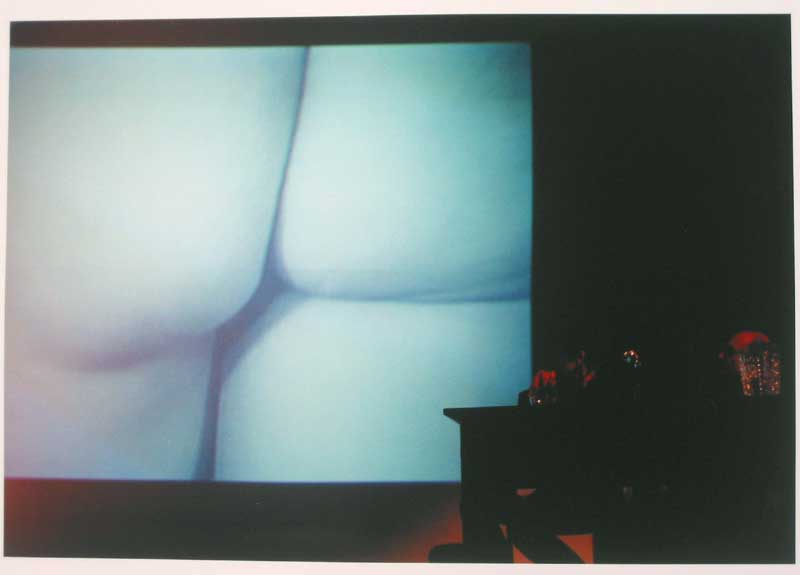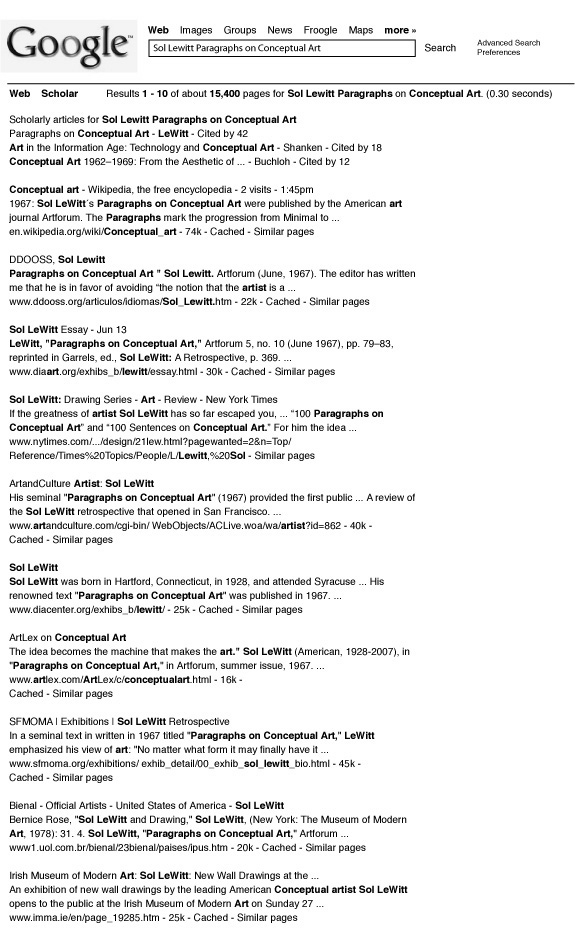The idea becomes a machine that makes the art.
...
Conceptual art is good only when the idea is good.
Sol LeWitt
Sol LeWitts Paragraphs on Conceptual Art

Seminar/Lecture, Lucy Lippard, Luis Camnitzer, Chrissie Iles, Sol LeWitt, Francis Nauman, Peter Wollen, Global Conceptualism: Points of Origin 1950's - 1980's, The New School, New York, 4/28/1999
4 images (20 x 24 inches, 51 x 61 cm)
Rainer Ganahl
Para-Graphs on Conceptual Art
On Sol LeWitt - Trying to be Witty
The editor has written me that he is in favor of stories on Sol LeWitt and Minimal Art of the 1960/70s that are personal and related to my work. This should be good news to both, my work and me. In regard to Sol LeWitt and Minimalism at large, I feel a bit like a kind of an ape in need of a civilized explanation. Using a technological metaphor, I googled his paragraphs on Conceptual Art which Ied me right away to You Tube, where some Viennese artist remade a version of John Baldessari's 1972 singing of his sentences, using 8 year old children. Different to Baldessari of 36 years ago who just selected sentences he liked, the kids read the beginning and marked the missing parts with 'dot, dot, dot.' To use a baseball metaphor, these paragraphs were made to be hit and turned into hits to be sung or fit into karaoke machines. I continue to strike out for myself.
Today, the statement that ideas or concepts are the most important aspects of art has become a perfunctory affair. It is intuitive that the art market has become a machine that makes the art. There is a reason to suppose, however, that commercially successful artists are out there to bore often emotionally dry viewers. Emotional kicks set in when expectations are financially interesting to collectors and dealers. Interesting enough Sol LeWitt belonged to one of the most selling artist of his period leaving many of his conceptual peers far behind. The art market is not necessarily logical. Like all markets, the art market is a device that is used at times, only to be ruined. Logic may be used to camouflage the real intent of dealers, collectors, curators and magazines, to infer a paradoxical situation. Their ideas need not be complex.
Concerning my Seminar/Lecture series my plan designs the work. They are like a machine that makes the art since I have selected the basic form and rules, i. e. photographing what I see while attending seminars and lectures. I have been engaged in this on going practice since 1995. In my case, it doesn't eliminate the arbitrary, the capricious, and the subjective since it reflects my personal interests in what is spoken and visible on these discursive occasions. This intellectual flaneurism that appears logical but is in fact intuitive is the reason for using this method. Once the work is out of my hands I have no control over the way a viewer will perceive the work. Intervening steps for my Seminar/Lecture works -scribbles, sketches, drawings done during the lectures or thoughts and ideas transcribed are of no interest to the final work. They do not show the thought my process of the final product. The Seminar/Lecture Lucy Lippard, Luis Camnitzer, Chrissie Iles, Sol LeWitt, Francis Nauman, Peter Wollen, Global Conceptualism: Points of Origin 195o's - 1980's, The New School, New York, 4/28/1999 I remember quite well since it was in relationship to an impressive exhibition at the Queens Museum with the same title that tried to show how Conceptual Art was a truly international phenomena. The show included more than a hundred artists from around the world and included also artists who lived their 'conceptualism' like Franz Kafka's 'hunger artist' - until oblivion / death / without much recognition and no value.
To be honest, from this lecture I don't remember Sol LeWitt. Instead I remember Lucy Lippard whose books I read and who's personal 'Good bye - Art world' - story was impressive. She also chose the best images, a naked butt by Yoko Ono which is less logical but intuitive, delivering an emotional kick on the rather dry presentations I visit so often. Projected pictures presented during lectures become thus part of my S/L work which renders my series into a true image processing machine. To work with this plan that is preset is one way of avoiding subjectivity when it comes to images within the image. Doing so caprice, taste and others whimsies are eliminated from the making of the art. The work does not necessarily have to be rejected if it does not look well, if the light conditions in the rooms are miserable or if the images show their snap shot quality - since during a lecture I'm just a listener in the role of a student without acting as a photographer or artist. Sometimes what is initially thought to be awkward will eventually be visually pleasing.
This last sentence applied to me when it comes to my first -most likely influential - contact of Sol LeWitt's work. As a teenager I hitchhiked in Italy and ended up in a Milan circle of kids who invited me one day to go with them to Varese, a village at the Italian Swiss border. Giovanni's father, Panza di Piumo had a villa filled with strange art works including a wall drawing by Sol LeWitt. As an unsophisticated high school student from the Austrian alps I was unable to comprehend the work logically but intuitively. Needless to say that I didn't remember any of the names and even forgot about this weekend until many years later, when art history entered my daily life and Nam June Paik became my teacher in Düsseldorf. A quasi-contact with LeWitt himself occurred in New York in the early 1990's when I was told by one of his assistants that he very much liked my show at Nordanstad Gallery that consisted mostly of conceptual wall paintings.
Opposite to most of the historical formation of conceptual art that has its focus on primary, abstract forms I have been interested in how abstract or elementary structures enter today's administrative and informational world. For me minimalism and conceptual design was more encountered in spaces that present and process information. I am interested in how knowledge and information is produced and disseminated in computers and on other technological interfaces. Asked about Sol LeWitt, I intuitively run his name through a search machine. Most ideas that are successful are ludicrously simple. Successful ideas generally have the appearance of simplicity because they seem inevitable. Therefore, my Google search wall paintings are at the center of today's attention focus. Today, all roads lead through a search engine where minimalism, functionality and capitalism meet. Sol LeWitt with his minimalist work definitely has become a maximalist concerning the impact of his work. If the Duchampian Ready Made paradigm belongs to the most important one in the 20th century, minimalist reduction and seriality might be the one with the second most relevant impact on contemporary art but having played one of the biggest influence on contemporary culture, in particular corporate culture: No corporate lobby, no bank, no high end condo layout without a reference to minimalism, and for that matter, few corporate logos, few machine and product designs without it either. Needless to say, the influence was somehow mutual, a two way street since the world of 'good design' had already been promoted by MoMa for decades, not even mentioning the accessability of the ideology of the Bauhaus. Nonetheless, because of this monumental impact of Sol LeWitt's work on art and culture, it might have been just logical that Sol LeWitt's persona simply escaped my memory, even though we did come across a couple of time and shook hands at openings.
Searching 'Sol LeWitt Paragraphs on Conceptual Art' on Google.com, 2008
wallpainting. - dimension variable
